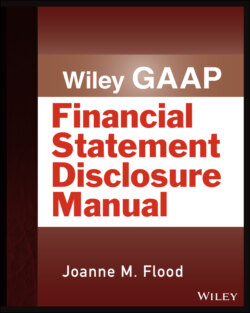Читать книгу Wiley GAAP: Financial Statement Disclosure Manual - Joanne M. Flood - Страница 43
ASC 210‐20, Offsetting
ОглавлениеPresentation In general, a debtor entity may offset assets and liabilities against each other if a right of setoff exists and certain specified criteria are met. (ASC 210‐20‐45‐2) The Codification permits offsetting when all four criteria listed below are met:
1 Each of the two parties owes the other determinable amounts (although they may be in different currencies and bear different rates of interest).
2 The reporting party has the right to set off the amount it owes against the amount owed to it by the other party.
3 The reporting party intends to set off the two amounts.
4 The right of setoff is legally enforceable.(ASC 210‐20‐45‐1)
Practice Pointer: If an entity has the ability to set off, but does not intend to use it, presenting the effect in the balance sheet is not representationally faithful. Criteria 3 requires judgment to discern the intent of the reporting entity. History may be an indicator of the entity's intent. (ASC 210‐20‐45‐4 and 45‐5)
When maturities differ, only the party with the nearest maturity can offset, because the party with the later maturity must settle in the manner determined by the party with the earlier maturity. (ASC 210‐10‐45‐3)
Entitles must apply their choices to offset consistently. Net receivables arising from application of ASC 210‐20 cannot be offset against net payables. (ASC 210‐20‐45‐12)
Taxes Payable The offsetting of cash or other assets against a tax liability or other amounts due to governmental bodies is acceptable only under limited circumstances. (ASC 210‐10‐45‐6) When it is clear that a purchase of securities is in substance an advance payment of taxes payable in the near future and the securities are acceptable for the payment of taxes, amounts may be offset. Primarily this occurs as an accommodation to governmental bodies that issue tax anticipation notes in order to accelerate the receipt of cash from future taxes. (ASC 210‐10‐45‐7)
Bankruptcy In particular cases, state laws or bankruptcy laws may impose restrictions or prohibitions against the right of setoff. (ASC 210‐10‐45‐8)
Repurchase agreements and reverse repurchase agreements ASC 210‐20‐45‐11 permits the offset of amounts recognized as payables in repurchase agreements against amounts recognized as receivables in reverse repurchase agreements with the same counterparty. If certain conditions are met, an entity may, but is not required to, offset the amounts recognized. The additional conditions for offsetting repurchase agreements and reverse repurchase agreements are:
1 The agreements must have the same explicit settlement date.
2 The agreements must be executed in accordance with a master netting agreement.
3 The securities underlying the agreements exist in “book entry” form and can be transferred only by means of entries in the records of the transfer system operator or the security custodian
4 The agreements will be settled on a securities transfer system that transfers ownership of “book entry” securities, and banking arrangements are in place so that the entity must only keep cash on deposit sufficient to cover the net payable.
5 Cash settlements for securities transferred are made under established bank arrangements that provide that an entity to have cash on deposit for net amounts due at close of business. The entity uses the same account for cash inflows and outflows related to the settlement. (Also see ASC 210‐20‐45‐14 through 17 for additional details.)
These conditions do not apply to amounts recognized for other types of repurchase and reverse repurchase agreements executed under a master netting arrangement. This does not mean that those amounts could not otherwise meet the conditions for a right of setoff. (ASC 210‐20‐45‐13)
Disclosures The disclosures required by ASC 210‐20 apply to:
Recognized derivative instruments accounted for in accordance with ASC 815, including bifurcated embedded derivatives, repurchase agreements and reverse repurchase agreements, and securities borrowing and securities lending transactions that are offset in accordance with either ASC 210‐20‐45 or ASC 815‐10‐45
Recognized derivative instruments accounted for in accordance with Topic 815, including bifurcated embedded derivatives, repurchase agreements and reverse repurchase agreements, and securities borrowing and securities lending transactions that are subject to an enforceable master netting arrangement or similar agreement, irrespective of whether they are offset in accordance with either ASC 210‐20‐45 or ASC 815‐10‐45.(ASC 210‐20‐50‐1)
The FASB has made it clear in its Background Comments for ASU 2013‐01 that the disclosure requirements do not apply to:
Loan and customer deposits at the same financial institution.
Financial instruments only subject to collateral agreement. The FASB views these as primarily credit enhancements.
Trade receivables and payables with a counterparty to be netted in the event of default. The FASB views these as primarily credit enhancements. In addition, requiring these to be disclosed would cause an undue burden on financial statement preparers.
Receivables and payables of brokers dealers resulting from unsettled regular‐way trades.
Offsetting relates to presentation only. If an asset and liability are presented net, it does not mean that the entity no longer has a contractual right or obligation. Therefore, to adequately inform the users, the Codification requires entities to disaggregate the relevant information. The disclosures must include:
1 The gross amounts for those recognized assets and liabilities,
2 The amounts offset to determine the net amounts presented in the balance sheet,
3 The net amounts presented in the balance sheet,
4 Amounts subject to an enforceable netting arrangement not included in the statement of financial position, instruments that the entity makes an election not to offset, and the amounts related to financial collateral.
5 The net amount after deducting “d” from “c” above.(ASC 210‐20‐50‐3)
Unless another format is more appropriate, the disclosures above must be presented in tabular format, separately by assets and liabilities. (ASC 210‐20‐50‐4)
In addition to the quantitative information, the entity must present a description of the rights of setoff for recognized assets and liabilities subject to an enforceable master netting or similar arrangement. (ASC 210‐20‐50‐5)
